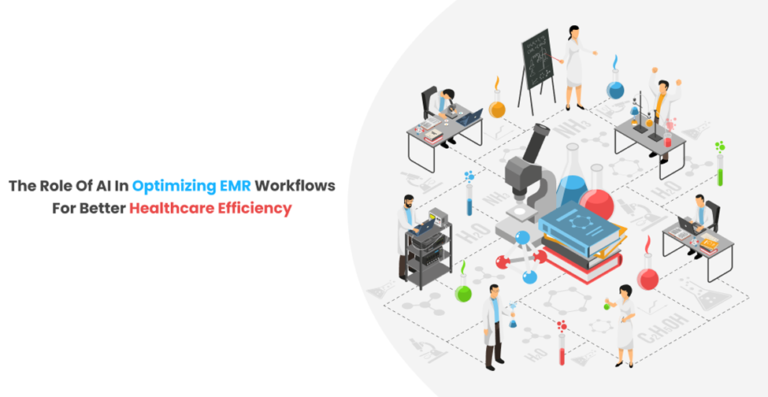Currently, the handling of patient data is critical due to the many changes that are affecting healthcare organizations every other day. EMRs are now considered crucial for modern healthcare organization support since they help manage and keep personal and detailed records of patients and improve organizational processes. Still, with the growth in the number and types of patients that require interventions and the massive amounts of data that have to be processed to determine these interventions, these electronic medical records often fail to suffice. It is at this juncture that Artificial Intelligence (AI) emerges to(seg) intervene and help change the face of healthcare professionals when it comes to the new EMR Software solutions.
Table of Contents
Understanding EMR Workflows
Familiarity with EMR workflow is critical to realizing the potential of the use of electronic medical records in healthcare organizations. In its simplest terms, an EMR workflow reflects the flow of activities used to handle information about patients, starting with data input and going through note creation and billing. As will be apparent in all activities like patient registration, appointment scheduling, and treatment planning, there is close cooperation between the clinical workers and the administrative workers.
However, general issues that affect effective communication, data entry mistakes, communication breakdown, and access to information delays hamper the efficiency of workflows. Studying and improving these processes allows healthcare organizations to increase patient outcomes, decrease paperwork, and increase overall productivity. Finally, knowledge of EMR workflows forms a premise to ensure the proper application of technologies to ensure patients receive better care and services.
Enhancing Data Entry and Documentation
Probably one of the most tedious processes in the entire process of delivering care is documentation. Users of EMR technology in the healthcare profession estimate that they type or click about half of their workday, which has caused them to be frustrated and burnt out. AI can enhance this workflow by using data entry techniques. Clinical Notes Analysis with NLP means that the AI could analyze and interpret clinical notes, which can reduce the effort required by our care providers from paperwork to more patient care.
For example, the voice input system allows the clinicians to speak their note-taking, and the voice-to-text tool in AI accurately records these notes into the EMR system. This method is not only time consuming but also it carries less risk of human error in tallying. Consequently, there is the possibility of increasing valuable time spent with the actual patient, and, therefore, the patient satisfaction rate improves.
Streamlining Patient Management
Smart EMR Software Solution are somewhat useful as they efficiently handle scheduling, follow-ups, and even reminders of patients. Another aspect is that intelligent algorithms can work with patient data and determine certain patterns, deviations from which may indicate, for instance, missed appointments or delays in the next visit. For instance, AI notifies the patients of the specific time that they need to come for the next appointment or when they need to come to complete some tests.
Also, AI plays a role in monitoring patient flow in the healthcare center, which is key in the organization. Through the use of big data analysis, it becomes possible for the system to predict the occurrence of busy hours, and match staffing appropriately. This makes it possible for healthcare providers to be on standby in readiness to meet clients’ needs for care hence improving our rate of hospitalization.
Benefits of AI in EMR Optimization
Numerous papers have presented how AI is changing how EMRs work and thus enhancing the handling of health care. Here are some key benefits of integrating AI into EMR optimization:
Enhanced Data Entry and Accuracy
AI may reduce data input procedures by handling repetitive work like filling fields and deriving data from documents. This is particularly beneficial as it eradicates the time consumed when trying to update patient records manually, as well as minimizes the chances of human errors.
Streamlined Patient Management
A valuable application of AI is that of analytics in the domain of health care which enables healthcare providers to analyze patterns within patients’ data affirmatively which can lead to better management of patients. With specific patient needs forecasted, providers can play follow-ups and interventions and enhance their respective patient outcomes and satisfaction.
Improved Clinical Decision Support
Big data analysis can be provided by AI algorithms that can generate suggestions for developing clinical practices. This helps doctors in the diagnosis of diseases, treatment recommendations, and the ability to tell which drugs interact with others, in a way that would benefit the patient.
Reduced Administrative Burdens
Some examples of which AI can take care of are scheduling and billing so that the healthcare staff can spend more time taking care of patients. This change results in effective workflow patterns and the possibility of more meaningful affiliation between providers and patients.
Conclusion:
Thus, AI is a critical enabler of Electronic Medical Record efficiency, the perpetuation of effective health delivery, and the improvement of patient outcomes in general. Automation, better data integrity, and valuable insights assist the healthcare providers in a way to do what matters, serve the patient. It is important to adopt these technologies to realize the needed transformation to prepare healthcare for the needs of future patients and professionals.


